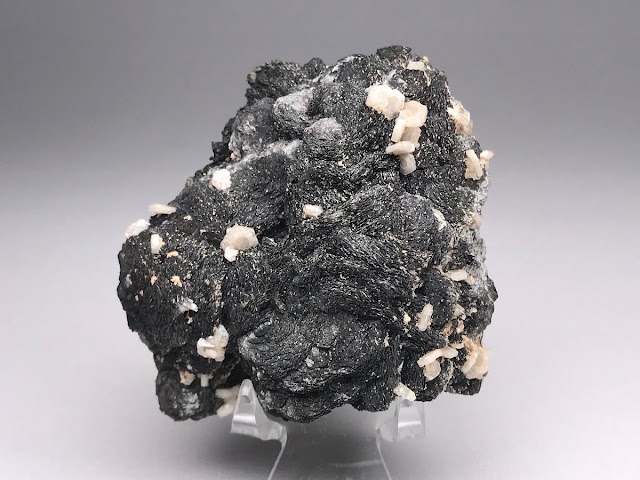足尾の閃亜鉛鉱と燐灰石 Sphalerite and Apatite from Ashio
栃木県日光市足尾町 足尾鉱山 連慶寺河鹿
Renkeiji Kajika Deposit, Ashio Mine, Nikko City, Tochigi, Japan
標本幅 width 55 mm / 重さ weight 131 g
やや緑色を呈する母岩の小片に、黒い閃亜鉛鉱がつき、その上に直径
足尾は日本でも有数の燐灰石の産地だ。砂川によれば最大で直径
Black sphalerite crystallizes on a piece of slightly greenish host rock with hexagonal platy apatite of
付属した古いラベルによると、この標本は連慶峙上4東ガマで採集された。足尾には熱水鉱脈鉱床と、カジカと呼ばれる塊状交代鉱床とがあって、連慶峙は後者に属する。またそのラベルにはわざわざ「鉄閃亜鉛鉱(マーマタイト)」と書いてある。閃亜鉛鉱は、亜鉛と硫黄とが
この標本にネオジム磁石を近づけると、けっこうくっつく(わたしの番付だと幕内中位くらい)。閃亜鉛鉱でここまで磁気感受性があるのはかなりめずらしいだろう。Zn0.5Fe0.5S まではいかなくても、鉄の量は相当多そうだ。高温で結晶化すると鉄が多く含まれやすいので(たとえば木下亀城「続原色鉱石図鑑」、保育社、1963)、かなり温度の高い熱水が関与したのかもしれない。あるいは磁硫鉄鉱が混在している可能性もないではないが、肉眼ではわからない。
それからこの閃亜鉛鉱は、紫外線のもとで黄色に蛍光する。燐灰石も紫外線下では累帯構造がはっきり見える。秋田県大館市近辺の黒鉱の閃亜鉛鉱は赤っぽく蛍光するが、やはり含まれる微量元素がちがうのだろう。おもしろいのは母岩のほうがむしろ明瞭に蛍光するところ。母岩は一様でなく、石英質の核のまわりを、緑色っぽい石がとりまいているが、蛍光するのはそのまわりの部分だけだ。ちなみにこの母岩の部分も磁石をひきつける。
The old label reads marmatite, an iron-rich variant of sphalerite. This specimen considerably attracts a neodymium magnet, indicating it has a lot of iron. It would be possible to contain pyrrhotite, but I can't say anymore without detailed analysis. The black sphalerite and a part of the host rock become yellow under a UV light, as shown below. Apatite also shows fluorescence emphasizing the zonal structure.
補足
木下の本は50年以上前の本なので、やや記述が古いかもしれないが、
6 : 5 > Zn : Fe > 5 : 1 のものを鉄閃亜鉛鉱(Marmatite)といい、さらに鉄分の多いものを Christophite というそうだ。これらは閃亜鉛鉱の亜種名で、鉱物学的な正式名称ではない。木下の本には鉄は最高で 26% (重量%)はいる、とあるが、この値がどこからきたのか不明だ。実際はもっと鉄分に富むものも知られており、Fe > Zn のものにはルダシェフスキー鉱(Rudashevskyite)という名前が与えられている(加藤昭、主要鉱物各説、無名会、2017)。Kinoshita wrote in his book published more than 50 years ago that marmatite denotes sphalerite that has composition of
6 : 5 > Zn : Fe > 5 : 1 , and that more iron-rich one is called christophite. Kinoshita also wrote that the maximum iron content of sphalerite is 26%. However, more iron-rich sphalerite has been known and a name of rudashevskyite is given to the one in which iron is richer than zinc.ラベルに書いてある産地だが、通洞とは地上と鉱山内部とをむすぶ幹線となる水平坑道のことで、足尾の場合この通洞坑があった場所を指す地名にもなっている。通洞駅というわたらせ渓谷鉄道の駅もある。この駅のそばに蓮慶寺というお寺があって、この付近に発達したのが連慶峙河鹿(文献によっては連慶寺という表記もあり)。そのあとの「上4」は、おそらく通洞レベルから数えて上方に4番目の水平坑道のレベルのことだろう(だいたい 140 m くらい上)。
This specimen was found at Renkeiji kajika deposit on the 4th upper level above the adit. Renkeiji is a name of temple near Tsudo station of Watarase Keikoku railway.
河鹿鉱床は、秩父古生層という古い地層、とくにチャート層に沿って多く分布する。足尾流紋岩をつくった比較的新しい時代の火山活動にともなう熱水の一部がチャート層を貫通したときにできたのが河鹿といわれる。文献(草薙忠明「足尾銅山連慶峙河鹿について」、鉱山地質 9号、1953)によると、渡良瀬川右岸に沿って河鹿が分布していて、連慶峙の南西の有越地域のほうが規模が大きいようだ。
Kajika deposit is considered to be generated by a hydrothermal mineralization in a paleozoic chart layer. Kajika deposits are mainly distributed on the right bank of Watarase river, and Arigoshi kajika, located at the south-west of Renkeiji, is bigger.
これは右側が連慶峙地域、左側が有越地域にあたるような断面図。この断面に限れば、連慶峙河鹿は通洞レベルより深部に発達していて、むしろ有越地域のほうが上4などの浅いところに河鹿が分布している(たとえば亜鉛河鹿、六百五十尺河鹿)。この文献は1950年当時の状況を書いているから、その後閉山までの20年間で新たな河鹿が開発された可能性もある。ちなみに亜鉛河鹿はその名の通り、鉄閃亜鉛鉱・磁硫鉄鉱を主体としたらしい(草薙忠明「足尾銅山亜鉛河鹿の地質構造と鉱化との関係」、岩石鉱物鉱床学会誌、1954)。
In the above cross section map, Arigoshi kajika is on the left hand side. Renkeiji kajika occurs at or under the adit level, and Arigoshi rather occurs at the shallower part like the 4th upper level.
足尾鉱山は、どうも奇妙な形の鉱物を多産するようだ。砂川の解説記事にはほかにも、鯵の楯鱗(ゼイゴ)状に結合した方解石とか、パイプ状の燐灰石とか、いろいろ紹介されていておもしろい。黄銅鉱も、ビロード様に輝く足尾式十二面体結晶とか、板状の結晶とか、いろいろある。後者の好標本を、アメリカのスミソニアン博物館が所蔵しているのをネットでみつけたので、リンクを張っておく。これなど、ひょっとしたら荒川の三角式黄銅鉱よりめずらしいかもしれない。
Ashio mine seems to produce minerals that have peculiar crystal habits. Ashio's chalcopyrite is also known to be special such as a dodecahedron crystal shining like velvet and a tabular crystal. I found a good example of the latter at the webpage of Smithsonian Museum. I guess that this is a rarer collection than Arakawa's triangular chalcopyrite.






